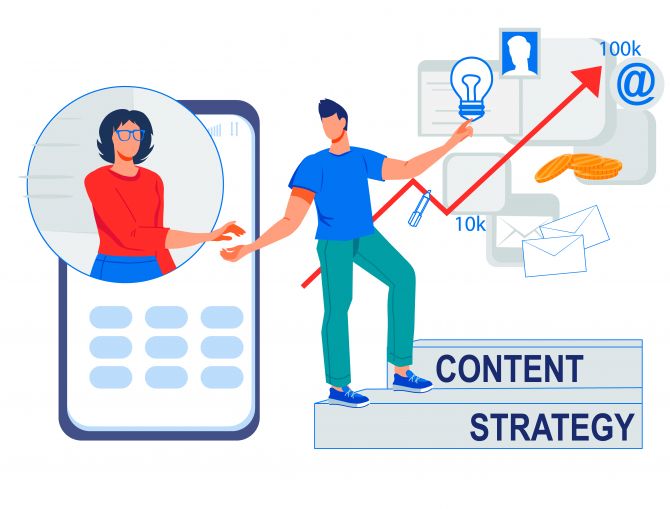
Creating high-quality content that resonates with your target audience is crucial for keeping your place in the digital marketing race. However, creating content without a proper strategy can waste resources. That's where content strategy comes in - it's the roadmap that guides your content creation efforts, ensuring that every piece of content produced is aligned with your business objectives and speaks to your audience's needs.
Welcome to our comprehensive blog post, where we will guide you through the essential elements of a successful content strategy. Our goal is to help you create a strategy that delivers results, from ideation to execution, with practical tips and tricks. Paying close attention to the details is crucial to ensure your content strategy is a resounding success.
Step 1: Define Your Objectives and Target Audience
The first step in developing a content strategy is to identify your target audience and define your business objectives.. Your content strategy should be aligned with your overall business goals and help you achieve them.
Start by asking yourself: Who are you creating the content for? What are the pain points, interests, and behaviours of your target audience? Developing detailed buyer personas can help you answer these questions and ensure your content resonates with your audience. After understanding the target audience and their user journey, think about what you want to achieve with your content. For example, do you want to increase brand awareness, generate leads, drive conversions, or something else?
Step 2: Conduct a Content Audit
Start your content audit with identifying the points in your target audience’s user journey where your value proposition can be communicated.
Before creating new content, taking stock of what you already have is essential. Conducting a content audit can help you identify gaps in your current content strategy, the points in the purchase journey where we are not communicating with the target audience, and provide insights into what content types resonate with your audience.
To begin, make a list of all your current content, such as blog posts, videos, social media posts, and whitepapers. Then, evaluate the quality and relevance of each piece of content, take a look at what competitors are doing and compare. Then make a list of all the touch points where the brand is not present and the kind of communication required at those points. This can be done through taking a closer look at the user journey, dividing it in phases (AIDA or AIDAR) and identifying the pain points at each stage. Your content strategy should include addressing these pain points. This will help you define channels and formats (website, email, social, video, etc.) for your content strategy.
Step 3: Develop a Content Plan
With your objectives and target audience in mind, it's time to start developing a content plan for different channels and formats. This should include the types of content you'll create, the topics you'll cover, and the channels you'll use to distribute your content.
Firstly, consider generating concepts for material that align with your target audience and commercial objectives. Then, consider the different types of content you could create - blog posts, videos, infographics, podcasts, etc. - and think about the channels you'll use to distribute your content - social media, email, your website, etc.
Once you've identified your content topics and formats, create a content calendar to help you stay organised and ensure that you're publishing content regularly.
Step 4: Create and Optimise Your Content
Now it's time to start creating your content. Whether you're writing a blog post, recording a video, or designing an infographic, ensure each piece of content is aligned with your business objectives and speaks to your audience's needs.
In addition to creating quality content, optimising your content for search engines is crucial. This includes conducting keyword research and incorporating relevant keywords into your content, optimising your meta descriptions and titles, and using header tags to organise your content.
Step 5: Distribute and Promote Your Content
Creating great content is only half the battle - you also need to distribute and promote your content to ensure it reaches your target audience. Use your content calendar to schedule social media posts, email newsletters, and other distribution channels.
Also, consider reaching out to influencers and other thought leaders in your industry to help amplify your content.
Step 6: Measure and Refine Your Content Strategy
The final step in developing an effective content strategy is to measure your results and refine your approach. Use analytics tools to track the performance of your content - how many views, likes, shares, and conversions are you getting? Identify which pieces of content are performing well and which ones need improvement.
Use these insights to refine your content strategy going forward. First, adjust your content calendar, topics, formats, and distribution channels based on what's working and what's not. Then, continuously test and optimise your content strategy to ensure that you're achieving your business objectives and meeting the needs of your audience.
Key Takeaways
Developing an effective digital marketing strategy requires careful planning, research, and execution. Here are some key takeaways to keep in mind:
- Define your business objectives and target audience before creating your content strategy.
- Map the user journey of your target audience, divide it in stages, identify the pain points of each stage and decide the communication that addresses these pain points
- Finalise channels and formats that are best suited to these stages and touch points
- Conduct a content audit to identify gaps and opportunities in your existing content.
- Develop a content plan that includes the types of content you'll create, the topics you'll cover, and the channels you'll use to distribute your content.
- Create and optimise your content for search engines.
- Distribute and promote your content on your own channels and with influencers and thought leaders in your industry.
- Measure your results and refine your approach based on what's working and what's not.
If you follow these tips and keep improving your methods, you can come up with a content plan that ticks all the boxes and goes great with your business objectives.






